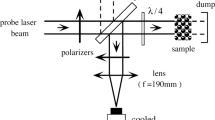Abstract
Why does time reversal involve two operations, a temporal reflection and the operation of complex conjugation? Why is it that time reversal preserves position and reverses momentum and spin? This puzzle of time reversal in quantum mechanics has been with us since Wigner’s first presentation. In this paper, I propose a new solution to this puzzle. First, it is shown that the standard account of time reversal can be derived based on the assumption that the probability current is reversed by the time reversal transformation. Next, this assumption is justified and the meaning of time reversal is clarified by analyzing the relationship between the rates of change and the instantaneous quantities which determine them. Finally, I explain how the new analysis help solve the puzzle of time reversal in quantum mechanics.
Similar content being viewed by others
Notes
I thank Phil Pearle and Rodi Tumulka for showing me a proof of this result.
Note that even though in the de Broglie-Bohm theory we can determine the transformation rule for the velocity of a Bohmian particle by its definition, which is assumed to be equal to the current velocity, we still need to resort to the time reversal invariance of the guiding equation to derive the standard transformation rule for the wave function. Then, why not directly assume the time reversal invariance of the Schrödinger equation? In my view, the de Broglie-Bohm theory does not help much in solving the puzzle of time reversal in quantum mechanics (cf. [11]).
This argument can also be used in Newtonian mechanics and Maxwell’s theory of electromagnetism. For example, in Newtonian mechanics, not only the standard velocity, which is defined as the derivative of position with respect to time, but also the intrinsic velocity [12], which determines the standard velocity, should be reversed by the time reversal transformation.
There have been worries about the measurability of the probability current in the continuity equation. For example, Sakurai wrote, “we would like to caution the reader against a too literal interpretation of j as \(\rho\) times the velocity defined at every point in space, because a simultaneous precision measurement of position and velocity would necessarily violate the uncertainty principle.” (Sakurai, 1996, pp.102, 103).
Take \(\rho (x)\) as an example. When assuming the psi-ontic view, the density \(\rho (x) = |\psi (x)|^2\) will be a physical property of the measured system. Then, what density is the density \(\rho (x)\)? Since a measurement must always be realized by a certain physical interaction between the measured system and the measuring device, the density must be, in the first place, the density of a certain interacting charge. For instance, if the measured system is charged and the measurement is realized by an electrostatic interaction between the measured system and the measuring device, then the density multiplied by the charge of the measured system Q, namely \(Q\rho (x)\), will be the charge density of the measured system in position x. Similarly, \(Q\mathbf {j}\) will be the charge current density of the measured system in position x. A detailed analysis of the origin of the charge density and charge current density can be found in [20].
References
Wigner, E. P. (1931).: Group Theory and its Application to the Quantum Mechanics of Atomic Spectra. New York: Academic Press (1959)
Callender, C.: Quantum mechanics: keeping it real? Br. J. Philos. Sci. (2021). https://doi.org/10.1086/715032
Roberts, B.: Three myths about time reversal in quantum theory. Philos. Sci. 84, 315–334 (2017)
Roberts, B. (2020). Time Reversal. The Routledge Companion to the Philosophy of Physics, Eleanor Knox and Alistair Wilson (eds)
Albert, D.Z.: Time and Chance. Harvard University Press, Cambridge, MA (2000)
Callender, C.: Is time ‘Handed’ in a quantum world? Proceedings of the Aristotelian Society 100(3), 247–269 (2000)
Ballentine, L.E.: Quantum Mechanics: A Modern Development. World Scientific Publishing Company, Singapore (1998)
Sakurai, J.J.: Modern Quantum Mechanics, Revised Addison Wesley, Reading, MA (1994)
Earman, J.: What time reversal is and why it matters. Int. Stud. Philos. Sci. 16(3), 245–264 (2002)
Malament, D.B.: On the time reversal invariance of classical electromagnetic theory. Stud. Hist. Philos. Mod. Phys. 35, 295–315 (2004)
Allori, V., Goldstein, S., Tumulka, R., Zanghì, N.: On the common structure of Bohmian mechanics and the Ghirardi-Rimini-Weber theory, British Journal for the Philosophy of Science 59 (3), 353. Section 4, 2 (2008)
Tooley, M.: In defence of the existence of states of motion. Philos. Top. 16, 225–254 (1988)
Sebens, C.: Quantum mechanics as classical physics. Philos. Sci. 82(2), 266–291 (2015)
Struyve, W. (2020). Time-reversal invariance and ontology. https://philsci-archive.pitt.edu/17682/
Aharonov, Y., Anandan, J., Vaidman, L.: Meaning of the wave function. Phys. Rev. A 47, 4616 (1993)
Aharonov, Y., Vaidman, L.: Measurement of the Schrödinger wave of a single particle. Phys. Lett. A 178, 38 (1993)
Gao, S. (ed.): Protective Measurement and Quantum Reality: Toward a New Understanding of Quantum Mechanics. Cambridge University Press, Cambridge (2015)
Piacentini, F., et al.: Determining the quantum expectation value by measuring a single photon. Nat. Phys. 13, 1191 (2017)
Pusey, M., Barrett, J., Rudolph, T.: On the reality of the quantum state. Nat. Phys. 8, 475–478 (2012)
Gao, S.: The Meaning of the Wave Function. In Search of the Ontology of Quantum Mechanics. Cambridge University Press, Cambridge (2017)
Author information
Authors and Affiliations
Corresponding author
Additional information
Publisher's Note
Springer Nature remains neutral with regard to jurisdictional claims in published maps and institutional affiliations.
Rights and permissions
Springer Nature or its licensor holds exclusive rights to this article under a publishing agreement with the author(s) or other rightsholder(s); author self-archiving of the accepted manuscript version of this article is solely governed by the terms of such publishing agreement and applicable law.
About this article
Cite this article
Gao, S. Understanding Time Reversal in Quantum Mechanics: A New Derivation. Found Phys 52, 114 (2022). https://doi.org/10.1007/s10701-022-00634-1
Received:
Accepted:
Published:
DOI: https://doi.org/10.1007/s10701-022-00634-1



